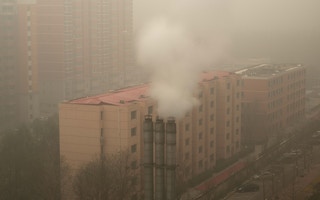Chinese banks are failing to consider the environmental risks of their investment and lending activities, and this oversight leaves them exposed to costs of RMB 11 trillion (US$1.69 trillion), a new report by environmental data consultancy Trucost has found.
Titled Accounting for Natural Capital Costs Associated with Chinese Financial Institutions – Banking Sector Case Study and launched on Saturday, the study shows that when banks invest in, or lend to companies, unforeseen environmental costs could undermine their financial returns.
Chaoni Huang, Trucost head of business development in Asia, noted that “Chinese banks and investors face a complex landscape of risks and opportunities resulting from the policies driving the transition to a clean, low-carbon economy”.
Risks facing investors include new laws which would require companies to pay fines for environmental damages, or to buy carbon credits to offset their emission. Natural resources in short supply could also make a firm’s supply chain more expensive.
The study, launched at the People’s Bank of China Green Finance Committee’s annual conference in Beijing, put a value for the first time on the environmental costs associated with the RMB 10.3 trillion that Chinese banks have given as outstanding credit to 35 resource-intensive sectors in China as at the end of 2014.
These sectors included agriculture, energy generation, steel, cement and chemical manufacturing.
Dirty sectors a poor investment
Through an economic modelling exercise, Trucost estimated the dollar value on the environmental impacts of these sectors including greenhouse gas emissions, air and water pollution, waste generation, water use, and change of land use.
The price of these consequences is also known as the natural capital cost. Natural capital refers to the total stock of natural and biological resources on Earth including water, land, air and habitats.
Trucost’s analysis shows that the natural capital cost of current outstanding credits by Chinese banks to the 35 sectors is RMB 11 trillion, meaning that each RMB 1 million of credit provided by Chinese banks could result in environmental impacts worth RMB 1.07 million.
Research also showed that the biggest natural capital cost is related to greenhouse gas emissions – the financial risk arising from this accounted for RMB 8.2 trillion of the total RMB 11 trillion.
Companies may have to start paying for emissions in future, as the Chinese government rolls out policies such as a national carbon trading scheme next year. Compulsory energy efficient retrofits for coal power plants by 2020 would also add to environmental costs.
With a RMB 1.2 trillion price tag, land use is the second highest natural capital cost of bank lending activities, said Trucost. Converting land for agriculture, petroleum and natural gas extraction disrupts valuable ecosystem services that forests provide, such as purifying air and water resources.
Coal power generation was the sector with the highest environmental costs, accounting for 26.1 per cent of all potential losses, found Trucost. According to its report, “managing the risks from this sector is a priority for China’s commercial banks”.
Banks which finance manufacturing companies should also be careful, because the government could close plants to reduce overcapacity and air pollution.
The agricultural sector also holds a hidden risk - although activities like rice farming, cattle rearing and poultry production accounted for just about 1.43 per cent of bank loans, they contributed to about 11.8 per cent of the environmental costs. Every RMB 1 million invested incurred between RMB 4.6 and 14.65 million in damages, highlighting the need for more sustainable practices in the sector.
Informed investing
Despite the steep financial cost of these environmental risks, Chinese financial institutions today lack the proper means to accurately assess and price natural capital costs in their investments, said Trucost.
To help plug this gap, Trucost partnered with Urban Finance Research Institute of the Industrial and Commercial Bank of China (ICBC) to create a tool that will help financiers better understand and manage natural capital risks.
This tool calculates the cost of damage to the environment and human health caused by air pollution, climate change and water scarcity among other environmental issues, and divides it by the corporate revenue of the sector to derive a “natural capital intensity” figure.
This information helps financial institutions “understand, quantify, and manage these risks,” said Trucost’s Huang. They can avoid investments that would accrue losses, and instead fund companies which are trying to be more sustainable, she added.
Zhou Yueqiu, director of ICBC’s Urban Finance Research Institute, added that the research provides “positive support” to help the banking sector optimise loan structure.
“In the future, we need more similar research and tools, and to actively strengthen the foundation of green finance in China,” he said.

















